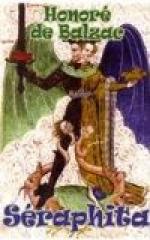“Their child was born,—the Seraphita we are now concerned with. From the moment of her conception father and mother lived a still more solitary life than in the past, lifting themselves up to heaven by Prayer. They hoped to see Swedenborg, and faith realized their hope. The day on which Seraphita came into the world Swedenborg appeared in Jarvis, and filled the room of the new-born child with light. I was told that he said, ‘The work is accomplished; the Heavens rejoice!’ Sounds of unknown melodies were heard throughout the house, seeming to come from the four points of heaven on the wings of the wind. The spirit of Swedenborg led the father forth to the shores of the fiord and there quitted him. Certain inhabitants of Jarvis, having approached Monsieur Seraphitus as he stood on the shore, heard him repeat those blissful words of Scripture: ’How beautiful on the mountains are the feet of Him who is sent of God!’
“I had left the parsonage on my way to baptize the infant and name it, and perform the other duties required by law, when I met the baron returning to the house. ‘Your ministrations are superfluous,’ he said; ’our child is to be without name on this earth. You must not baptize in the waters of an earthly Church one who has just been immersed in the fires of Heaven. This child will remain a blossom, it will not grow old; you will see it pass away. You exist, but our child has life; you have outward senses, the child has none, its being is always inward.’ These words were uttered in so strange and supernatural a voice that I was more affected by them than by the shining of his face, from which light appeared to exude. His appearance realized the phantasmal ideas which we form of inspired beings as we read the prophesies of the Bible. But such effects are not rare among our mountains, where the nitre of perpetual snows produces extraordinary phenomena in the human organization.
“I asked him the cause of his emotion. ’Swedenborg came to us; he has just left me; I have breathed the air of heaven,’ he replied. ’Under what form did he appear?’ I said. ’Under his earthly form; dressed as he was the last time I saw him in London, at the house of Richard Shearsmith, Coldbath-fields, in July, 1771. He wore his brown frieze coat with steel buttons, his waistcoat buttoned to the throat, a white cravat, and the same magisterial wig rolled and powdered at the sides and raised high in front, showing his vast and luminous brow, in keeping with the noble square face, where all is power and tranquillity. I recognized the large nose with its fiery nostril, the mouth that ever smiled,—angelic mouth from which these words, the pledge of my happiness, have just issued, “We shall meet soon."’




